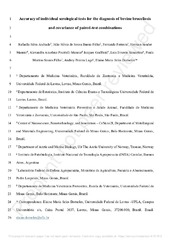| dc.contributor.author | Andrade, Rafaella Silva | |
| dc.contributor.author | Oliveira, Marina Martins de | |
| dc.contributor.author | Bueno Filho, Júlio Sílvio de Sousa | |
| dc.contributor.author | Ferreira, Fernando | |
| dc.contributor.author | Godfroid, Jacques Xavier Leon | |
| dc.contributor.author | Lage, Andrey Pereira | |
| dc.contributor.author | Dorneles, Elaine Maria Seles | |
| dc.date.accessioned | 2025-02-07T13:37:17Z | |
| dc.date.available | 2025-02-07T13:37:17Z | |
| dc.date.issued | 2023-11-21 | |
| dc.description.abstract | The direct methods for diagnosis of bovine brucellosis have several limitations, therefore serological tests are the basis for the diagnosis of the disease. However, a meta-analysis estimating the diagnostic sensitivity (DSe) and diagnostic specificity (DSp) on the main tests used in bovine brucellosis control programs worldwide has not been performed. This systematic review and meta-analysis aimed to estimate the DSe, DSp and thereby accuracy of serological tests individually used in the diagnosis of bovine brucellosis. The databases CABI, Cochrane Library, PubMed/MEDLINE, SciELO, Scopus and Web of Science were used to select articles. The search resulted in 5308 studies, of which 71 were selected for systematic review using quality assessment tools and 65 studies were included in the meta-analysis. For the meta-analysis, 178 assays and 11 different serological tests were considered. To estimate DSe and DSp of the tests, studies were divided according to animal selection for the studies: (1) studies that carried out a random or consecutive selection of participants (noncasesingle bondcontrol studies) and (2) all studies, including casesingle bondcontrol studies. Considering only the non-case-control studies to estimate the DSe, the tests that exhibited the best and worst performance were the iELISA test (indirect enzyme immunoassay - bacterial suspension as antigen - BS) (96.5%, 95% CI: 94.1–97.9%) and 2ME (2- mercaptoethanol test) (85.0%, 95% CI: 79.6–89.1%), respectively; while for DSp, the FPA (fluorescence polarization assay) (99, 7%, 95% CI: 99.5–99.8%) and PCFIA tests (protein concentration fluorescence immunoassay) (78.5%, 95% CI: 70.0–85.1%) showed better and worse performance, respectively. Overall, our results showed an overestimation in the DSe and DSp of the eleven serological tests assessed when casesingle bondcontrol studies were included in the meta-analysis, which is a concern considering its impacts on the time and costs associated with populational diagnosis of the diseases, since several of these tests are routinely used in the control and eradication programs of bovine brucellosis worldwide. Furthermore, the tests that exhibited the best DSe and DSp, iELISA (BS) and FPA, respectively, are relatively easy to perform and interpret and the test which showed the best overall accuracy was FPA. | en_US |
| dc.identifier.citation | Andrade, Oliveira, Bueno Filho, Ferreira, Godfroid, Lage, Dorneles. Accuracy of serological tests for bovine brucellosis: A systematic review and meta-analysis. Preventive Veterinary Medicine. 2024;222 | en_US |
| dc.identifier.cristinID | FRIDAID 2236850 | |
| dc.identifier.doi | 10.1016/j.prevetmed.2023.106079 | |
| dc.identifier.issn | 0167-5877 | |
| dc.identifier.issn | 1873-1716 | |
| dc.identifier.uri | https://hdl.handle.net/10037/36434 | |
| dc.language.iso | eng | en_US |
| dc.publisher | Elsevier | en_US |
| dc.relation.journal | Preventive Veterinary Medicine | |
| dc.rights.accessRights | openAccess | en_US |
| dc.rights.holder | Copyright 2024 The Author(s) | en_US |
| dc.title | Accuracy of serological tests for bovine brucellosis: A systematic review and meta-analysis | en_US |
| dc.type.version | acceptedVersion | en_US |
| dc.type | Journal article | en_US |
| dc.type | Tidsskriftartikkel | en_US |
| dc.type | Peer reviewed | en_US |


 English
English norsk
norsk